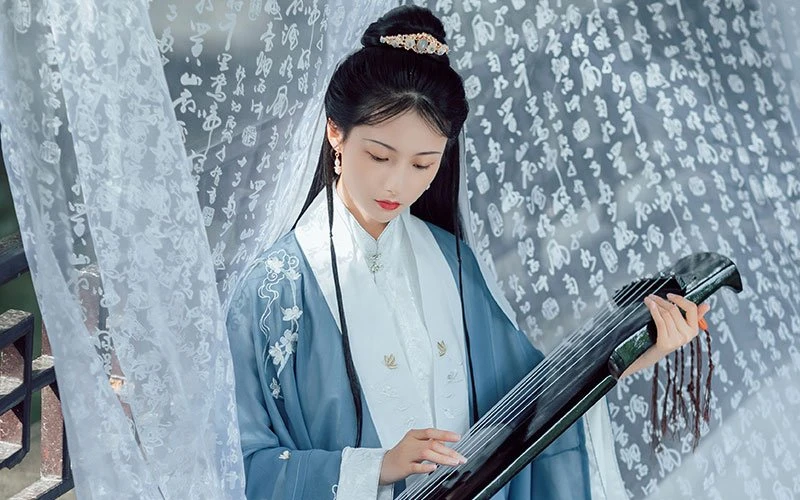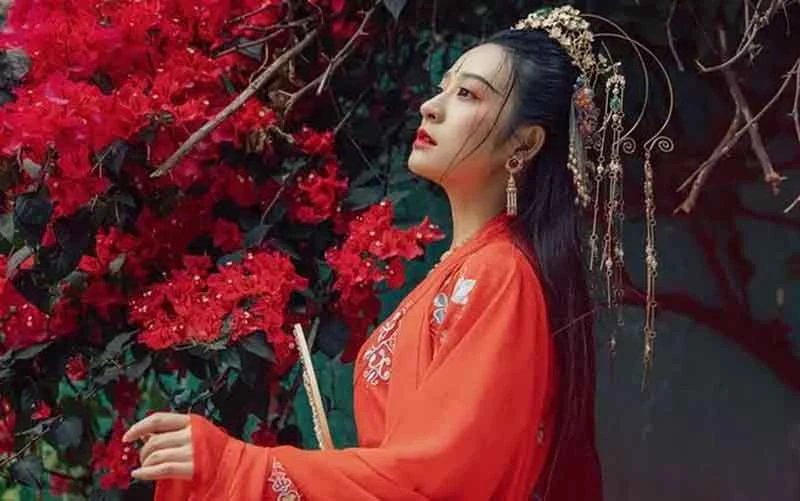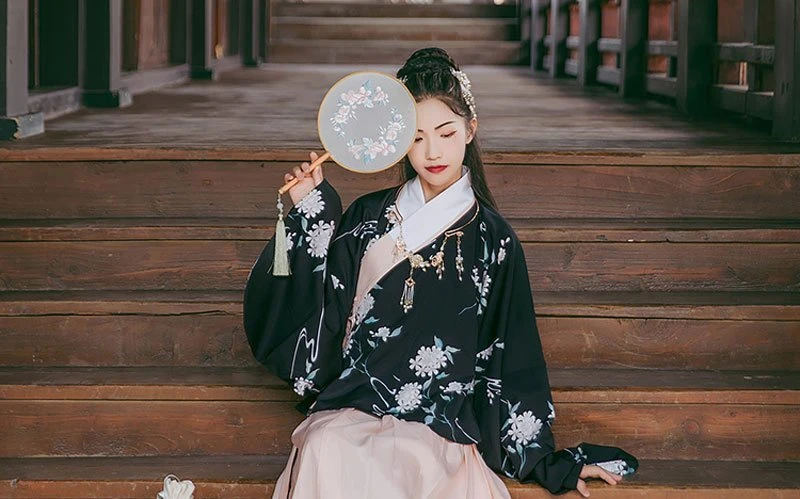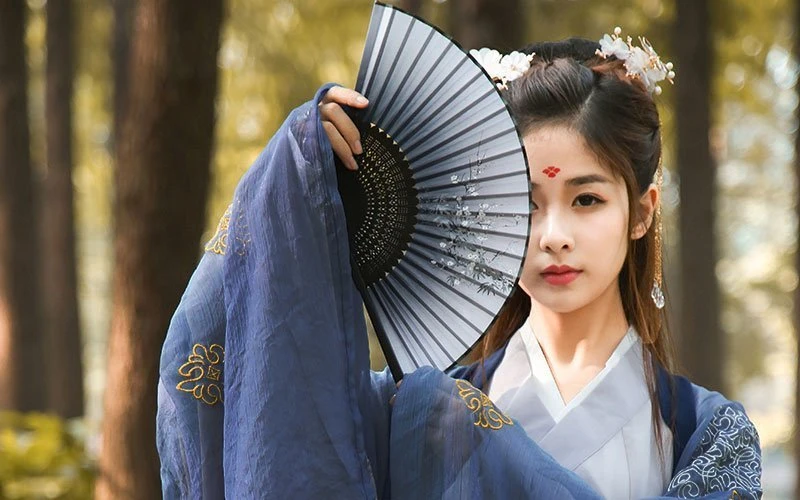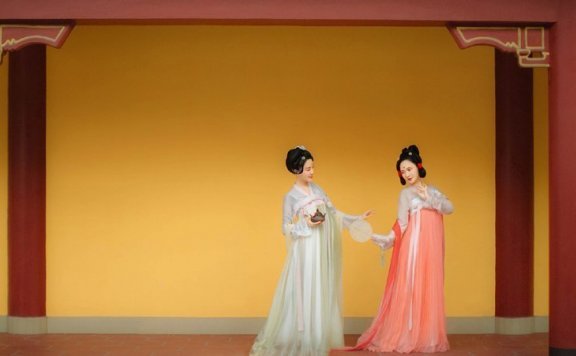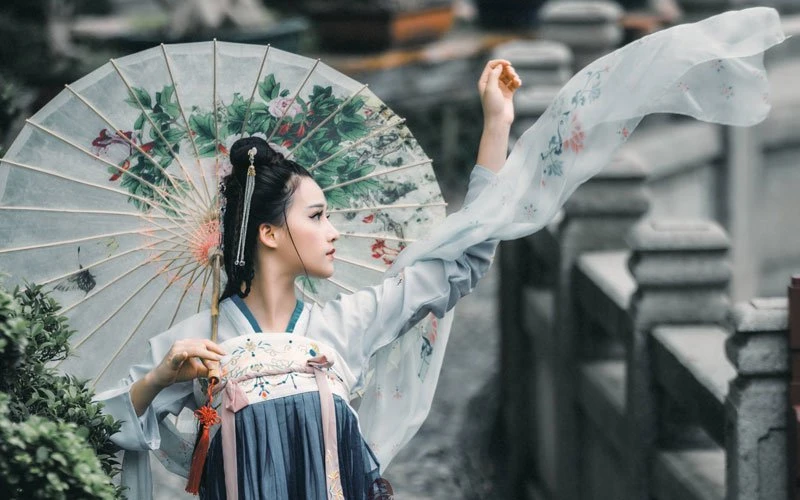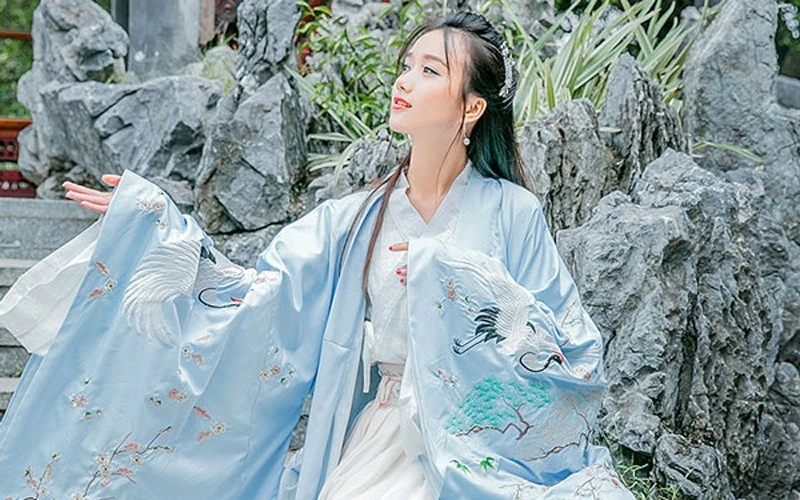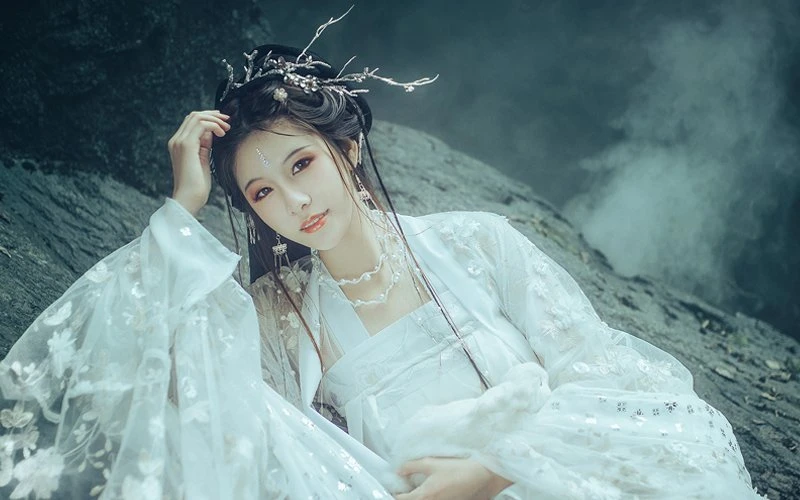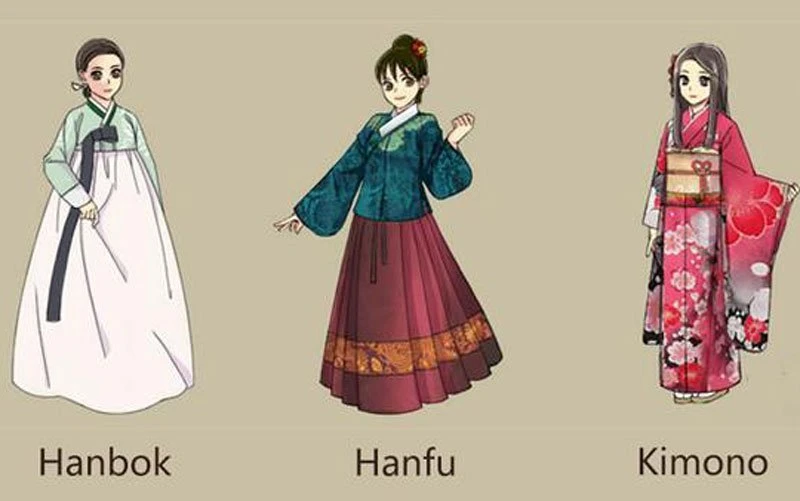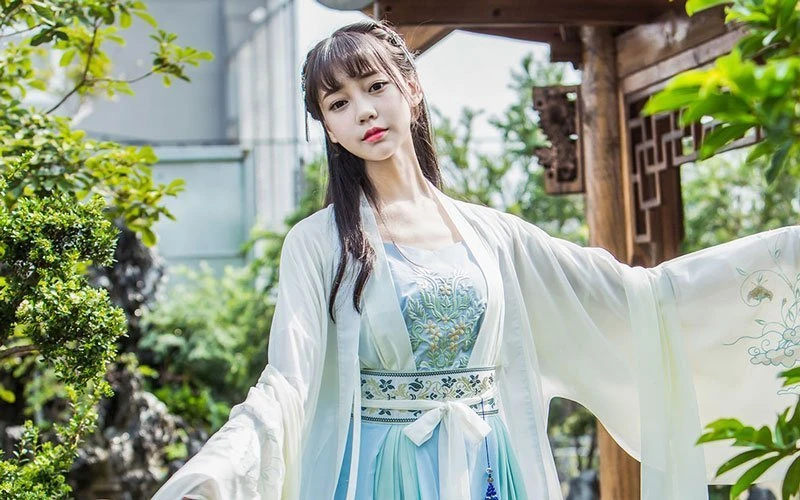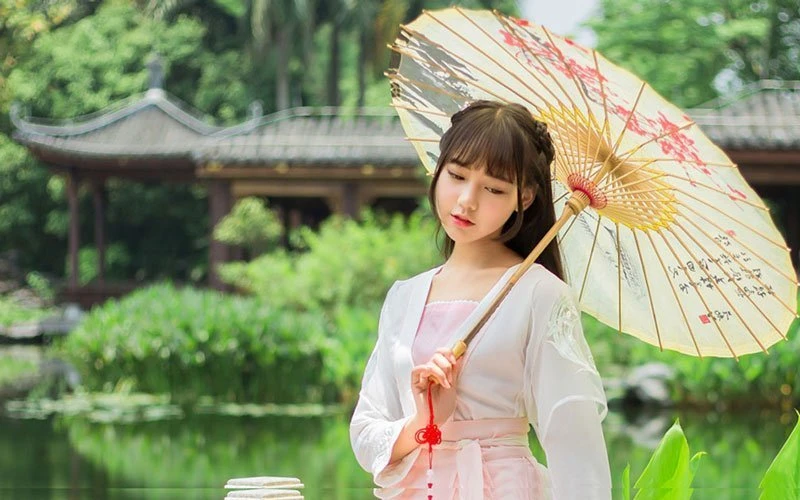-
The Most Classic Hanfu of All Time
In the process of evolution, there are dozens or even hundreds of styles of Chinese clothes. This article mainly introduces the most classical styles of Chinese Hanfu clothes. Women's clothing Suit Ruqun(襦裙) Ruqun is a kind of hanfu, also call: Shanqun (衫裙), short clothes worn on the upper body, call "Ru", and the dress of the lower body, call "Qun", together call "Ruqun". It is a typical "Shangyi Xiachang(top clothes and underdress) " form. Ruqun has an obvious feature: short top and long dress. The Ruqun appeared in the Warring States Period, Ruqun was worn by ordinary people(female) until the end of the Ming and Qing Dynasties. Jiaoling Ruqun/ Shanqun(交领襦裙/衫裙) Jiaoling Ruqun is a kind of Ruqun, the main feature is: the top collar is cross. It is quite common in the Song Dynasty. Wearing method: First: Wear top clothes, Align the collar of the top clothes; Tie a knot in right Jin(襟, the chest part of the top); Tie a knot in left Jin. Second: tie up the dress, Put the dress in front of you, wrap the skirt behind you; Two sides of the dress overlap behind; Folding outwards the pressing on the inner layer of dress;…- 24.1k
- 9
-
6 FAQs Let You Know More About Hanfu
1. What’s Hanfu? It refers to the traditional costumes worn by the Han people from the time of the Yellow Emperor’s reign to the late Ming and early Qing dynasties (the Qing dynasty was interrupted for more than 300 years due to the policy of the rulers and was not revived until the 21st century). The Hanfu is not the same as the Han dynasty dress, but the Han dynasty dress, belongs to the Hanfu. In fact, the costumes of the Tang, Song, Yuan, Ming, and Qing Dynasties are also collectively known as Hanfu. Nor does Hanfu clothing refer to all Chinese, and ethnic minorities have their own traditional dress. 2. What’s the difference between the Hanfu and the Han element? The Han elements are inspired by traditional clothing, and can be used in fashion, or the traditional Han clothing can be modified and designed to be more convenient for modern life. Examples include the short-sleeved skirt based on the Qixiong Ruqun and the Han element based on the Jiaoling Ruqun, in which the features of the Han dress are retained, but the form has been completely changed. The Han element does not have strict form requirements, the design is… -
The Hanfu Etiquette You Should be Focusing on
Hanfu costume is not only the costume of the Han Dynasty, but the national costume of Han nationality. After more than 300 years of vicissitudes of life, it was annihilated in history and forgotten by future generations. Nowadays, many people still mistakenly believe that Hanfu clothes were eliminated naturally because of the inconvenience of their broad gowns and sleeves. It has been misread as an ancient costume, ridiculed as traversing, acting, making a show, and even recognized as kimono and hanbok costume. Characteristics of Hanfu Is it true that Hanfu clothes only have an appearance? Are there any details that can express Chinese traditional culture? The main feature of Hanfu is: Crossed-collar with the right pattern Restrain the waist by ropes Loose clothes with long-wide sleeves Han clothes give people a feeling of chic and free temperament. These characteristics are not only different from the costumes of other nationalities, but also the kimonos and Korean hanbok costumes produced by the influence of Chinese costumes in neighboring countries. Small details are hidden in the Shenyi The common Shenyi (深衣) is that the upper and lower clothes are linked together, with different colors of cloth as the edge, so that the body…- 1.4k
- 0
-
A Brief Introduction to Hanfu's Fans Culture
In Chinese culture, accessories are a language of beauty. They are an extension of clothing expression. With accessories, Hanfu can be more appealing. Fans are one of the common accessories in Hanfu culture. This article will lead you to understand the history of Hanfu's fans. Fans have about three thousands of history in China. After thousands of years of evolution and improvement, they have developed into hundreds of fans' families. Fans were originally known as the "Five Ming Fans (五明扇, Wu míng shàn)" in history, was invented by the "Shun" (舜, Chief of the Ancient Tribal Alliance of China). In the Yin and Zhou Dynasties, appeared a kind of "Di Fan" (翟扇, Dí shàn) made of the colorful pheasant tail feathers, so there is a saying of "Feather Fan". At that time, the fan was not used to fan the wind, but to serve as the emperor to ward off the wind and avoid the sand. It can be classified into two categories: First, Flat Fans (平扇), can not be folded. Brief introduction: during the Warring States, Qin, and Han Dynasties, flat fans became the mainstream of fans at that time, used by both emperors and civilians. In the Western Han… -
10 Tips on Hanfu You Have to Know
Q1: There was no Hanfu sewing machine in ancient times. What was it used to make clothes? A:Of course, ancient people sewed by hand. As early as the Paleolithic Age, cavemen on the top of the mountain could sew animal skins with bone needles. With the development of society, in ancient China, women learned to tailor, sew, and embroidery patterns from childhood. Ancient clothes were sewn by hand with needles and threads, and there were many sewing techniques. Q2:There are so many pleats in the hanfu dress we are wearing now. What made the pleats of dress in ancient times? A: In ancient times, there were irons. The earliest iron was a kind of torture tool. Later, it was slowly used for ironing clothes. The shape is different from dynasty to dynasty. Some are like spoons, some are like pots and bowls. At first, it was bronze iron, then it was metal iron and porcelain iron. Ancient people often put red charcoal or hot water in the ironironed, and then ironed clothes. Q3: The styles of Hanfu are long sleeves and long skirts. Will the ancients wear them in summer? A: The ancients wore light clothes when they were hot.… -
What is a Hanfu Clothing? - Traditional Chinese Costume
In recent years, traveling to China has become more and more popular around the world. Many people come to enjoy the unique life of China, taste delicious food, visit beautiful scenery, and experience Chinese traditional culture. But you may find out it is rare to see people wearing traditional Chinese costumes in their daily lives. It seems like traditional clothing has been forgotten by them. So, you might have a question, what is Chinese traditional dress, Cheongsam, Qipao, or Kimono? Hanfu – The Traditional Costume of China Each country's traditional costumes are one of the symbols that reflect countries' ancient cultures and how native citizens were influenced by the regional environment. China has a long history of more than 5,000 years. Undoubtedly, Hanfu, as the most typical traditional costume of China, is a very important part of Chinese national culture. But compared with other traditional cultures, such as Chinese painting and calligraphy, Hanfu is not getting proper status and glory in the Chinese Culture Circle. Though with its disappearance in some ears, Hanfu still remains its typical features today due to its strong vitality. The clothing of Buddhism, Taoism, and many minority nationalities in China still maintains the characteristics…- 4.3k
- 3
-
What Does Hanfu Represent
Traditional costumes of the Han nationality Hanfu doesn't refer to Han Dynasty Costumes, but refers to the traditional national costumes of the Chinese Han nationality and is one of the oldest national costumes in the world. Hanfu is the most suitable combination of Chinese traditional culture in art and poetry, chess and calligraphy, music and dance, and tea ceremony. In the process of inheritance and development of history, Hanfu fully demonstrated the moral connotation of the ancients Benevolence, Righteousness, Courtesy, Wisdom, Trust, and it is also an important symbol of pure Chinese traditional costume art. Costumes in the gods' culture There are many flying clouds in Dunhuang murals, one by one is pure and beautiful, the dress is elegant, the ribbons are flying, and people can see the scenery after the sights, and the heart feels clear. It reflects the beauty of ancient costume art. Most of the flying costumes fully demonstrate the rich and beautiful human background of the Tang Empire and the gorgeous and beautiful costume features of that era. It can be seen that the costume itself is part of the culture, and it has deep connotations behind it. The profoundness of the Hanfu clothing culture Wearing…- 1.7k
- 0
-
The Difference Between Male and Female Ruqun Hanfu
The previous article's introduction focuses on women's Ruqun, and then we introduce men's Ruqun. The men's Ruqun is a male dress, composed of a top blouse and a lower dress, and the upper jaw is mostly handed over(Jiaoling). Compared with the women's skirts, the men's skirt style and pattern are plainer. "Zhou Yi(周易)" said that “Yellow Emperor, Yao, Shun is wearing clothes and the world is ruled”, which shows that in the Yellow Emperor's era, the tops of the blouses were the styles of the ancient Chinese people. This is the prototype of the Ruqun (a top blouse and a lower dress)of the next generation, costumes of the blouses, and other costumes. Although its specific shape still needs further research, but the suit of a top blouse and a lower skirt lays the foundation of Hanfu. Until the appearance of Zhiju, Quju, and so on, the number of people wearing Ruqun(Ru dress) has been reduced, but the official high-standard men's dress was still the Ruqun system(a top blouse and a lower dress), which continued until the Ming Dynasty. The traditional dress of Hanfu is an enclosed skirt, which is made up of several pieces of skirts and is connected to…- 5.9k
- 3
-
About Ruqun, You Should Know These
In the previous article, we introduced the Ruqun(襦裙), The Ruqun is composed of a short top and a long dress, that is, composed of a top and a lower dress. Song Suzhen's "Silkworm" poem: "I don't worry about the bread bait, I have fortunately had a Ruqun(Ru dress)." The style of the Ruqun has appeared in the Warring States period. The collar of the scorpion is divided into "Jiaoling Ruqun" and "Zhiling Ruqun". The waist of the dress is divided into"Zhongyao Ruqun", "Gaoyao Ruqun" and "Qixiong Ruqun". Ruqun is classified according to whether they are clipped or not. The Ruqun can be divided into single Ruqun and double Ruqun, single Ruqun close to the shirt, and double Ruqun are close to coat. Next to introduce is "Banbi (半臂, half arm)", it and the shawl constitute an important part of the Ruqun. "Banbi" classification: 1.according to the collar type, which can be divided into : Duijin half-armed dress Jiaoling half-armed dress Tanling half-armed dress (Tang Dynasty). It is a short-sleeved top for summer use in ancient China. It was only popular in the private sector and was convenient for the daily life and labor of the working people. The length of…- 1.7k
- 2
-
4 Tips You Should Know about Ruqun
The Ruqun(襦裙) is one of the earliest and most basic forms of clothing in the history of Han costumes. From the Warring States period with physical evidence, at the end of the Ming and Qing Dynasties with the "shaving and easy clothing". Is the most basic form of traditional Han costumes. In the meantime, more than 2,000 years, although the length and width have changed, the basic form has always maintained the original style. The Ruqun(襦裙) consists of the lower dress and the upper jaw (is short coat) and is generally called the Changfu (常服, uniform). According to the collar type, the Ruqun can be divided into: "Jiaoling Ruqun (交领襦裙, cross collar Ruqun)" "Zhiling Ruqun (直领襦裙, straight collar Ruqun)" According to the waist position of the dress, can be divided into: "Zhongyao Ruqun (中腰襦裙, a middle waist Ruqun)" "Gaoyao Ruqun (高腰襦裙, a high waist Ruqun)" "Qixiong Ruqun (齐胸襦裙, a chest Ruqun)" the Jiaoling Ruqun: the cross-collar dress is quite common in the Song Dynasty, it is characterized by the captain for the cross-collar.Can be subdivided into three: Jiaoling-Qiyao Ruqun(交领-齐腰襦裙,cross-collar Qi waist Ruqun): Qiyao Ruqun: dress's waist and waist are flush. Jiaoling-Gaoyao Ruqun (交领-高腰襦裙,cross-collar high waist Ruqun): Gaoyao Ruqun: The line…- 4.4k
- 2
-
The Difference between Hanfu Kimono and Hanbok
Many friends who have just contacted Hanfu will find that Kimono and Hanbok (Korean clothes) are similar to Hanfu in many ways. This article takes you to know the differences between Hanfu, Kimono, and Hanbok. Hanfu vs Kimono During the Nara period in Japan, the period of China's prosperous Tang Dynasty, Japan sent a large number of sent envoys to China to study culture, art, and law systems, including the clothing system. In the early days, the kimono was a replica of the Tang suit. At that time, they also imitated the Tang system and issued a "clothing order". So far, Japan still refers to the kimono as "Wu suit", which means clothes from Wudi (now Jiangsu and Zhejiang) in China. Although the kimono came from the development of Hanfu, it has developed its own national characteristics after a long period of history. Waistband: Hanfu: Hanfu usually has a narrow waistband; Kimono: there is no tie on the kimono placket, and the waist is wide with a fabric. Neckline: Hanfu: Hanfu neckline clothing is close to the back of the head; Kimono: In the kimono, the neckline of an ordinary woman's neck wrapped her neck tightly, and the geisha…- 32.5k
- 2
-
What is the Basis of a Set of Hanfu
The Evolution of Hanfu Hanfu, the Chinese costume, the traditional Chinese clothing system, also known as Chinese clothing, can not be confused with "Tang suit" and "kimono". Its origins can be traced back to “Xuanyuan, Huangdi is wearing clothes and the world is ruled” from the Yanhuang(炎黄) era, and the world ruled until the end of the Ming Dynasty (mid-17th century). Based on the national culture of the Han nationality (and the predecessor of the Han nationality the Huaxia nationality), a clothing system with national characteristics was formed in the process of natural cultural development and ethnic integration. The Composition of a Complete Set of Hanfu Hanfu, the Chinese costume, is divided into a formal dress and negligee. From the style of composition, mainly divided into: "Yishang(衣裳) system": (The clothes worn in the upper body and the skirt worn in the lower body are separate,), "Yishangsystem" is the earliest uniform in Hua Xia nation. "Shenyi(深衣) system": (The clothes worn in the upper body and the skirts worn in the lower body are stitched together.). "Ruqun(襦裙) system" (Ru mean short top). "Tongcai(通裁) system" (Long shirt, cloak. Tongcai means that connected without a seam, and 'ShenYi' is sewed together after cutting). Among these…- 1.9k
- 1
-
The Origin and Current Situation of Hanfu
Any good things are tempered, and Hanfu is the same. Hanfu has a history of thousands of years, but in the past three hundred years. Hanfu has experienced many setbacks. What is Hanfu Hanfu, the "traditional costume of the Han nationality", is also known as "Chinese clothing crown", "Huafu", "Chinese costume" and so on. It was from the"Xuanyuan, Huangdi is wearing clothes and the world is ruled", until the Ming Dynasty demise. Han nationality with the Huaxia nationality as its predecessor, according to "Zhou Li", respecting "the law of heaven and earth, the unity of nature and man, the doctrine of the mean" and so on, with the "Huaxia-Han" culture as the background and leading ideology. Focusing on the Chinese ceremonial culture, a set of unique Han nationality styles formed in extensive historical practice, clearly different from other ethnic groups' traditional clothing and apparel system. It contains wedding dresses, formal dress, sacred clothes, mourning clothes, uniforms, and other clothing that can adapt to various occasions. Hanfu is the embodiment of China's "state of etiquette" and "splendor China", it carries the outstanding craftsmanship and aesthetics of the Han people's dyeing and weaving embroidery, inherited more than 30 Chinese intangible cultural heritage…
